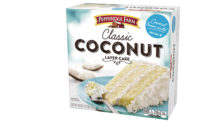In a retail landscape that demands that snacks and baked goods have it all—great taste, affordable pricing, innovative flavors, recognizable ingredients and boosted nutrition—one category in particular is rising to the challenge: cookies.
While Oreos and Chips Ahoy still maintain a captive audience, the cookie category is seeing strong differentiation. Cookie brands are offering new takes on tried-and-true recipes to add innovative and healthier options to the mix.
According to data from IRI, Chicago, sales of cookies were up 1.76 percent in the 52 weeks ending March 19, 2017, reaching $8.2 billion. Mondelez International still leads the pack, responsible for $3.1 billion in sales. Private label saw a strong performance, up 6.29 percent to $1.2 billion, and Pepperidge Farm was up 5.92 percent to reach $391 million. Top-performing brands included Nabisco BelVita, which grew 14.28 percent to reach $303.2 million in sales; Nabisco Oreo Thins, up 76.96 percent to reach $127.0 million; and Pepperidge Farm Milano, up 9.91 percent to reach $151.0 million.
“We see handheld treats as a trend,” explains John McIsaac, vice president of strategic business development, Reiser, Canton, MA. “Some years, bars or muffins are hot. Cookies have always been a staple, but the growth of many niche bakers has made cookies hot again.”
Artisan appeal
If you ask Theresa Lancaster, marketing manager, McCormick Flavor Solutions, Hunt Valley, MD, one of the main drivers influencing new ingredients and flavors in the cookie space is the craft movement. “Cookies that are less uniform in appearance with imperfections are being sought, as they have a homemade appeal,” she says.
And from that trend, others grow: Lancaster says that flavors inspired by artisan and rustic ingredients, which lend a unique or romantic touch, are growing in popularity. She cites flavors like apple cider, sage and molasses as on the rise, since they deliver a “rustic and comforting experience.”
Creating a homemade-inspired cookie begins with ingredients that consumers recognize from their own pantries. That’s why Lancaster says forward-trending ingredients like coconut oil, dark chocolate and whole grains, as well as classic natural sweeteners like honey and maple syrup, are all making waves in the cookie aisle.
At Baker Perkins Inc., Grand Rapids, MI, Mark Glover, account manager, sees familiar ingredients like oats, peanut butter, nuts, raisins and chocolate chips as on trend, since consumers want to “eat less, but eat better.”
The key is that cookies are no longer seen as a “kid-only,” after-school snack. “There’s an emerging market for cookies with more adult-like appeal, featuring value-added nutritional ingredients such as protein, nuts, fruits, seeds, spices and especially chocolate,” says Pam Stauffer, global marketing programs manager, Cargill, Minneapolis. “Growing consumer awareness of ingredients such as turmeric, cinnamon and ginger also provide more exotic and nuanced flavor profiles that make the extra calories worth it for a special occasion.”
Opportunities exist for cookie brands to tap into new and exciting flavors that appeal to adults who want a little something different from their childhood cookie. Lancaster says that “complex and layered flavor experiences” combine the sweet hallmark of cookies with something a bit out of the box. The result? Sweet and salty flavors (like salted caramel) as well as sweet heat options (like coconut and ginger).
Building a better cookie
When discerning consumers raise the bar, they often do so by demanding some kind of health benefit, even in an indulgent category like cookies. And, mirroring trends in the snack and nutritional bar category, protein is leading the way, appealing to “fitness lovers, athletes, lower-carb dieters and people looking to use a cookie as a meal replacement,” says Jill Motew, founder, Zemas Madhouse Foods, Highland Park, IL. She recommends using protein-rich quinoa or whey in these next-generation cookies.
“While it may have started as a niche market, in recent years, the high-protein trend has gone decidedly mainstream,” says Stauffer. “Consumers will continue to buy traditional high-protein shakes and bars, but opportunities also exist for innovative bakers to capitalize on the trend.” She suggests pea and soy protein as top ingredient contenders for cookies.
Expanding the ingredient range even further, Nesha Zalesny, technical service manager, Fiberstar, Inc., River Falls, WI, says combinations of high-protein flours—from almond to coconut, or even garbanzo bean flours—are where opportunities lie, since they can increase protein content and also replace wheat flour in some recipes.
Along these lines, nuts and nut butters check two boxes in that they provide protein content, but also are recognizable on the label. “Nuts are considered a healthy natural source of protein, and with the increased consumer demand for protein, companies are exploring alternative nut butters like almond and cashew butter as innovative cookie ingredients,” adds Lancaster.
In addition to protein, fiber is also in the spotlight, especially since consumers understand the obesity epidemic, says Zalesny. People want more nutritional snacks that help them feel fuller longer. FIberstar offers Citri-Fi natural citrus fiber, which can hold seven to ten times its weight in water due to its high surface area, and can maintain the fresh-baked quality of cookies over their shelf life.
Cargill offers Oliggo-Fiber chicory root fiber to meet demand for fiber. The ingredient also allows for sweetener reduction—another important trend transforming cookies.
“We are seeing a strong interest in invert cane syrup and organic evaporated cane syrups, as companies are removing high-fructose corn syrup to meet non-GMO requirements,” adds Jim Kappas, vice president of sales and marketing at Malt Products Corp., Saddle Brook, NJ.
The bottom line is that by adding ingredients like grass-fed whey protein, omega-3s and fiber, cookies can compete directly with nutritional bars, says Lancaster, which opens the category up to new consumers and aligns the cookie category with the better-for-you trend while still delivering on indulgence.
Indulgence light
It’s not that consumers don’t want an indulgent cookie from time to time. Zalesny sees opportunities for growth in product line extensions that co-brand or incorporate cookies into other categories like confectionery. “Cookies are also being used in other categories like ice cream, yogurt, breakfast bars or cereal as an inclusion,” she points out. “This indulgence category is competing with other sweet snacks that have grown in prevalence over the past few years.”
Look no further than cake-inspired cookies—boasting flavors like red velvet, lemon, or birthday cake, complete with sprinkles—for evidence of this, as manufacturers try to capitalize on the cupcake trend. For example, Flowers Foods launched Mrs. Freshley’s Cake Crisps in February 2017.
To balance the indulgence factor, cookie brands are switching up their servings by offering thin cookies. “Think of it as ‘indulgence light,’” says Stauffer, citing Oreo Thins as one standout example of this trend. The cookies contain about one-third fewer calories than original Oreos.
“There has been a trend of moving from thicker or larger types of cookies to thins and minis,” says Ricardo Rodriguez, marketing manager of confectionery and bakery, Ingredion Incorporated, Westchester, IL. “Consumers are driving this trend, as they want these indulgent types of products, but without the guilt associated with larger sizes or packages.”
Several thin cookies have entered the playing field this year. Mondelez International added to its thin cookie lineup with Chips Ahoy! Thins in January. Snyder’s-Lance debuted Snack Factory Chocolate Chip Dessert Thins in March. HannahMax came out with Cookie Chips in April, offering both Sea Salt Caramel and Coconut White Chocolate varieties. Farmhouse Thin & Crispy Cookies from Pepperidge Farm also landed on shelves in April. And Mrs. Thinster’s CookieThins unveiled Key Lime Pie and Meyer Lemon flavors in May.
“The days of the giant cookie are waning as brands seek to help their customers enjoy a cookie with all the great taste they are used to, but with fewer calories and less sugar,” says Stauffer. “Cookies are undergoing a significant transformation, second only to the beverage category. The door is clearly open for innovation in the cookie category, but some rules remain unchanged: Taste will continue to be the ever-present arbiter of success. Brands will have to balance providing indulgence and great taste, while also delivering products with a solid nutrition profile.”













